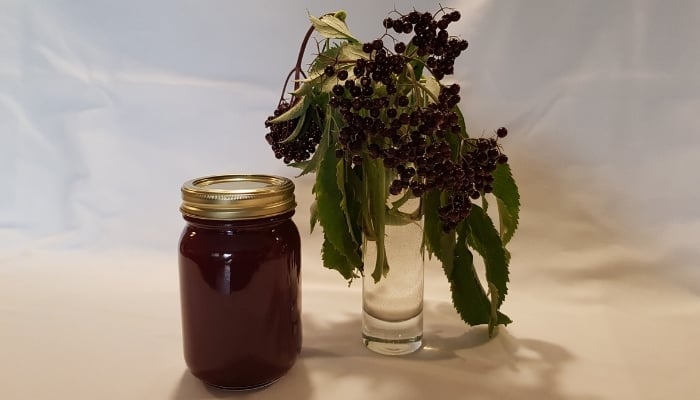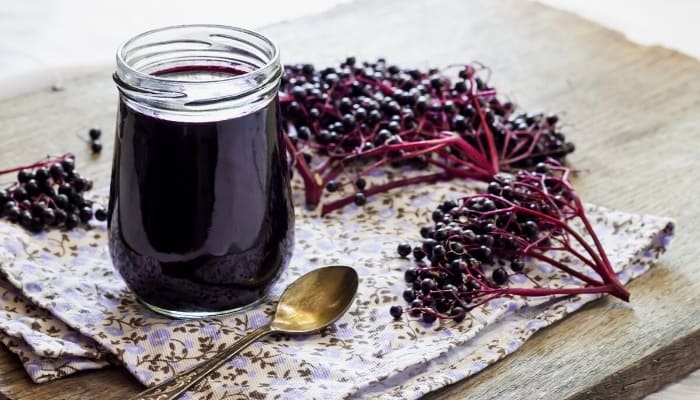Elderberries are derived from either the European or American elderberry tree and widely utilized as a key ingredient in various products such as wine, medicine, pie, and syrup.
How do you tell if elderberry syrup is bad? The surest way to tell if elderberry syrup is bad is by checking the container for mold. If you’re storing the container in the fridge, it shouldn’t go bad for approximately 90 to 180 days. In the freezer, elderberry syrup can be stored for much longer periods of time and then thawed for use.
Read on below to learn everything you need to know about elderberry syrup going bad, including what to look for, storage tips, and more!
Elderberry Syrup Freshness Guide
Freshness is important when it comes to the quality of your elderberry syrup. When stored properly, elderberry syrup stays “fresh” for up to 6 months.
However, it may go bad as quickly as 4 or 5 days if left outside of the fridge for too long.
In the freezer, you can store elderberry ice cubes or frozen syrup as long as you like and then thaw them out and use them one by one.
In the following sections, we break down how elderberry syrup should be stored, how quickly it spoils in various conditions, and what to look for in case your syrup has gone bad or is fermenting.
Does Elderberry Syrup Go Bad?
Elderberry syrup has a rough shelf-life (in the fridge) of approximately 90 to 180 days if stored properly. If the syrup isn’t sealed or is accidentally left open, it may go bad much quicker.
On the counter, the syrup may last as little as 4 or 5 days before beginning to ferment.
Stored in the freezer, elderberry syrup can last for years. All you need to do is pull a pack out and defrost it. The catch is that it won’t be tasty if you freeze it a second time.
Signs Elderberry Syrup Has Gone Bad
The number one sign that elderberry syrup has gone bad is the way it smells when it sours. The syrup goes from having the scent of heavenly nectar to slightly sour fruit.
Visually, when the elderberry syrup in your fridge goes bad, you’ll notice mold, which at first appears to be specks of dirt. By the time you notice it’s not dirt but live growing mold, your syrup is already shot.
What Happens if You Drink Expired Elderberry Syrup
If you happen to drink bad elderberry syrup, it won’t kill you, but that’s not to say the experience will be enjoyable (or without consequence).
When you accidentally drink expired elderberry syrup, you are likely to feel one or more of the following symptoms:
- Nausea
- Diarrhea
- Dizziness
- Blurred vision
- Vomiting
- Weakness
How Long Does Elderberry Syrup Last in the Fridge?
Generally speaking, elderberry syrup lasts for a minimum and maximum of 90 to 180 days in the fridge.
Freezing the elderberry syrup while it is fresh and storing it in the freezer part of your fridge extends the shelf-life by several months (or even years, if you don’t mind a watered-down flavor).
How Long Is Elderberry Syrup Good for Out of the Fridge?
Depending on the recipe that you use, your elderberry syrup should last at room temperature for up to 4 or 5 days. That said, after the second or third day, you need to check it for mold or fermentation.
The sourish smell is the first sign that your elderberry syrup isn’t good anymore. You may also notice dark mold spots.
How To Store Elderberry Syrup
The most popular method for storing homemade elderberry syrup is in glass mason jars with tight-fitting lids stored in the fridge.
So long as you bottle it up and close the lid nice and snug, jars of elderberry syrup last between 90 and 180 days when kept cold (again, depending on your recipe).
Freezing Elderberry Syrup
If you opt to freeze your elderberry syrup or the leftovers that don’t fit in jars, it’s really simple. All you have to do is pour the syrup into ice trays and freeze it.
Once the ice cubes are frozen, you can store them all in an airtight freezer bag.
Alternatively, you may also pour elderberry syrup off into smaller plastic containers with tight lids or even Ziploc baggies for that matter.

Fresh Elderberry Syrup Recipe
Now that you know how to tell if your elderberry syrup is good or bad and how long you can store it safely, it’s time to have a look at a fresh elderberry syrup recipe!
1. Gather Supplies
The first step is gathering fresh elderberries or otherwise getting your hands on at least 2 pounds of them!
It is best to make syrup in the summer when the berries are ripe. If the berries aren’t already destemmed, take the time to remove their stems now.
You also need a small piece of ginger and a cup of honey. Shred the ginger before moving on to the next step.
2. Steam-Juice Berries for 30 Minutes
If you have a steam juicer, stick your berries into the top part of the steam juicer, and let it run for half an hour. Once the berries are mostly broken down, add them to a saucepan, and set them on the stove over medium-high heat.
3. Add the Juice and Ginger to the Saucepan
If you are working with at least 2 pounds of berries, you should have around 4 cups of “sauce” at this point.
Add the ginger to the saucepan, and let everything simmer for another 20 to 30 minutes, stirring occasionally.
Allow more time on the stove if the sauce hasn’t been reduced down to just 2 cups by now.
4. Strain the Ginger Out of the Saucepan
When your liquid has simmered down to 2 cups in the saucepan, remove it from the stove, and strain the loose ginger pieces out of the mix.
5. Add a Cup of Honey and Mix Into Syrup
Once the sauce is off the stove and the ginger is removed, it’s time to add your cup full of honey. The honey seals the recipe, turning it into syrup.
6. Store It Properly
With your elderberry syrup freshly prepared, it’s time to store it. You have a few choices at this point:
- Mason jars with lids
- Glass bottles with corks
- Ice trays
- Freezer bags
Just be sure to keep your newly created product cold, either in the fridge or freezer.
How To Make Elderberry Syrup Shelf Stable
There are two basic ways to make your elderberry syrup shelf stable:
- Can it, being sure to follow safety guidelines
- Make a tincture instead of a syrup
Canning Elderberry Syrup
You may make elderberry syrup with little issue only if you make sure your recipe has the right level of acidity.
In other words, your elderberry syrup will need more acids, like lemon juice, mixed into it before canning it.
A relatively common canning recipe for elderberry syrup is:
- 3 cups filtered water
- 1/3 cup sugar or 1/4 cup honey
- 1/4 cup lemon juice
Elderberry Tincture vs. Elderberry Syrup
Elderberry tinctures are used for everything from pain medicine to a treatment for the common cold.
The main difference between tinctures and elderberry syrup is that for tinctures, the elderberries are doused in alcohol, typically vodka or brandy, for preservation, and for syrups, usually only water and sweetener are added to the berries.
Tinctures are medicinal, taken for painful joints, the flu, and more… and they don’t taste good! However, they also last for up to 10 times longer than syrups.
Related Questions:
Is Fermented Elderberry Syrup Safe?
Believe it or not, fermented elderberry syrup, in moderation, is even healthier than fresh elderberry syrup. When it is fermented, elderberry syrup gives your body a massive beneficial bacterial boost.
Does Elderberry Syrup Help With Colds?
Elderberry syrup has long been used as a homemade cold and flu remedy. It is packed with antioxidants, vitamin A, and vitamin C.
Elderberry syrup is also thought to be antiviral as well, making it even more impressive as a cold or flu treatment.
Is Elderberry Syrup Good for Allergies?
Elderberry syrups work well for clearing sinus passages and cleaning up infections as well as easing the symptoms thanks to the natural diuretic and laxative properties found in it.
All you need to do is take some tincture or enough syrup by mouth, and you’ll have up to two weeks of natural protection from allergies.
Conclusion
Elderberry syrup is good for so much more than just sipping from a glass. It’s also used as natural medicine to combat the cold, flu, muscle pain, and more.
Just remember, if it smells like sour fruit, has dark specks that look like dirt, or looks moldy, it’s probably fermenting (and isn’t good for drinking anymore).
At any rate, you have between 3 and 6 months to enjoy your syrup unless you prefer to freeze it!
Now that you know how to make it and how to tell when it turns bad, you’re all set to try out the easy-to-make elderberry syrup recipe above!

